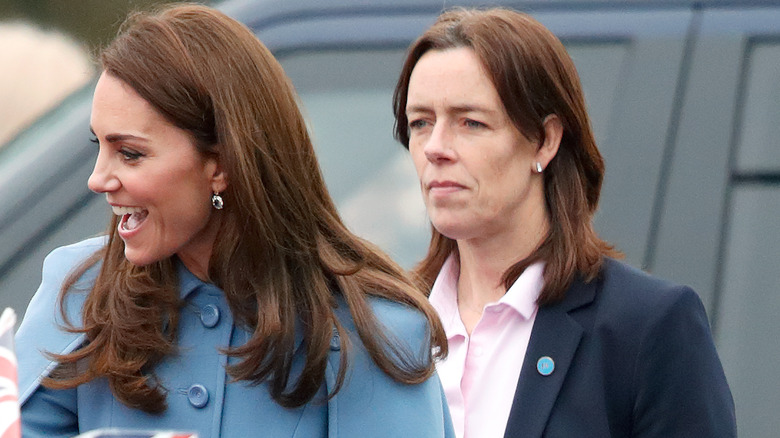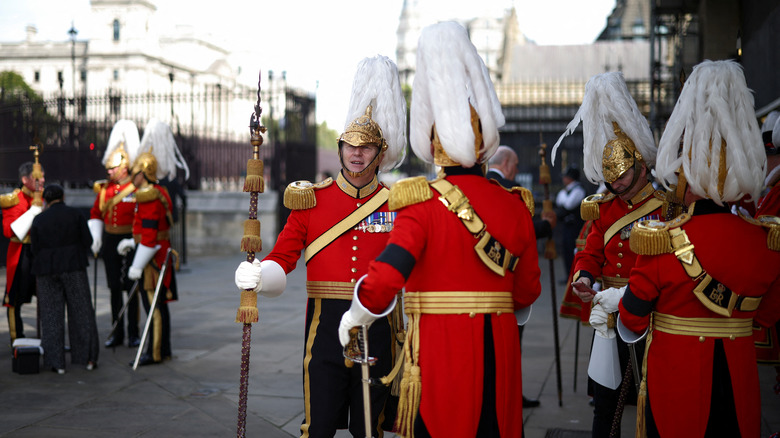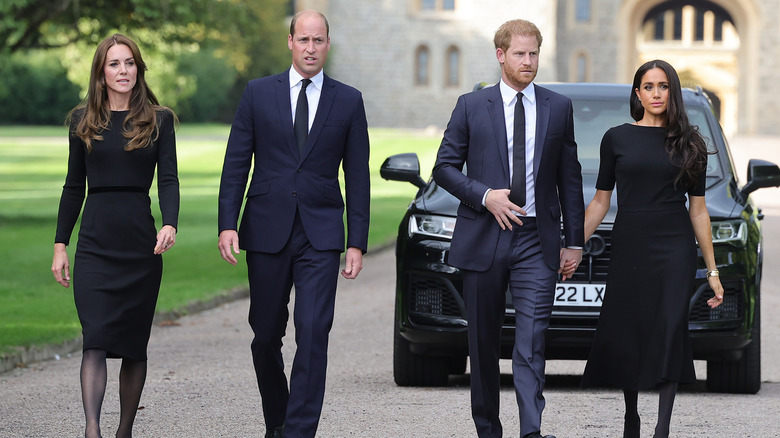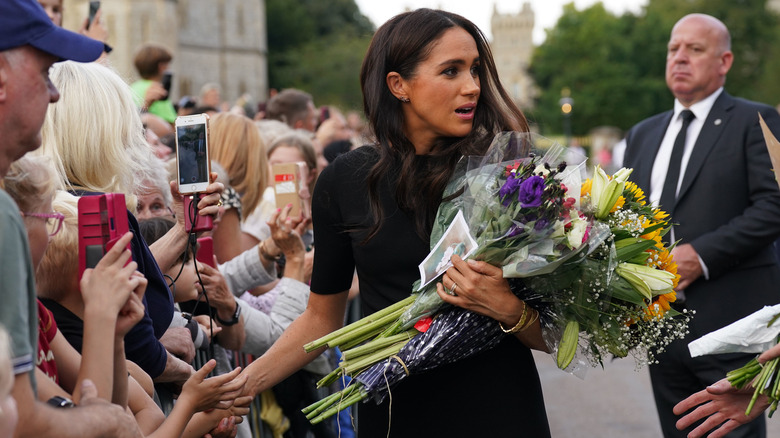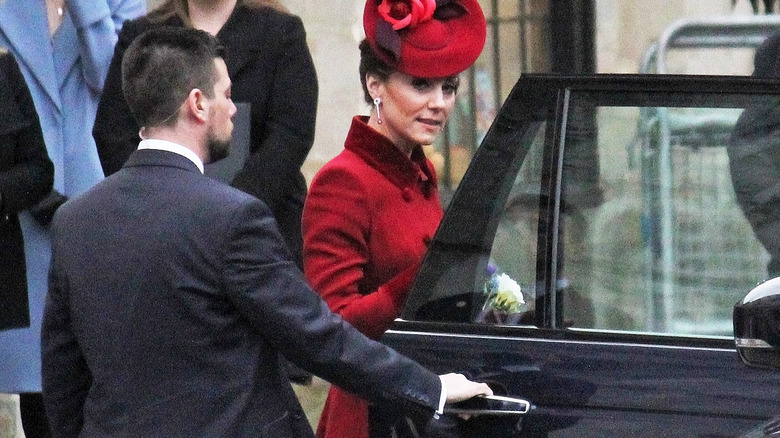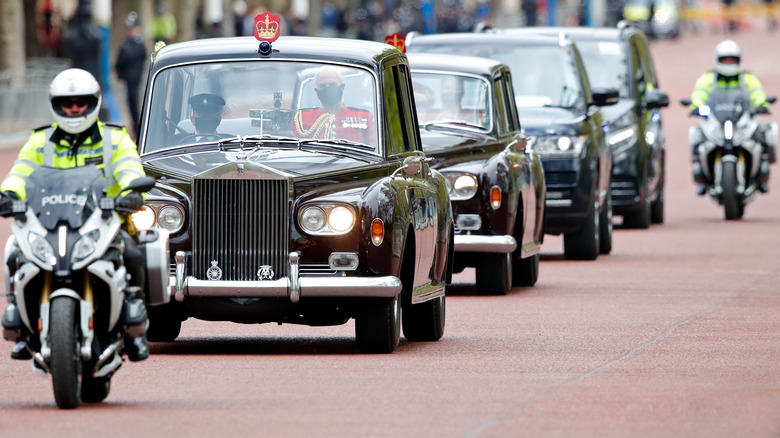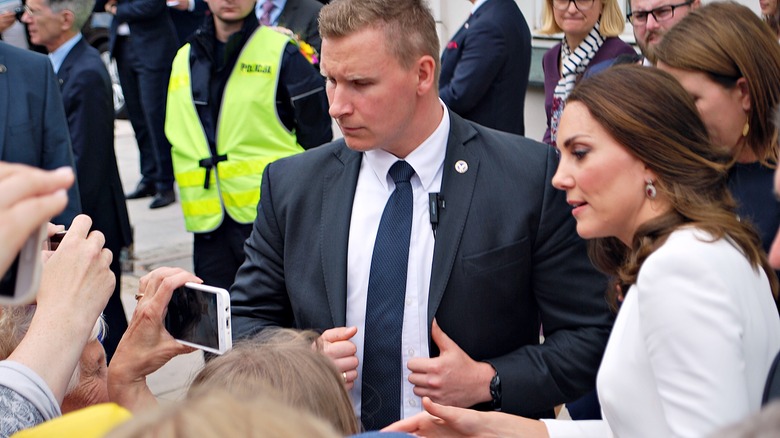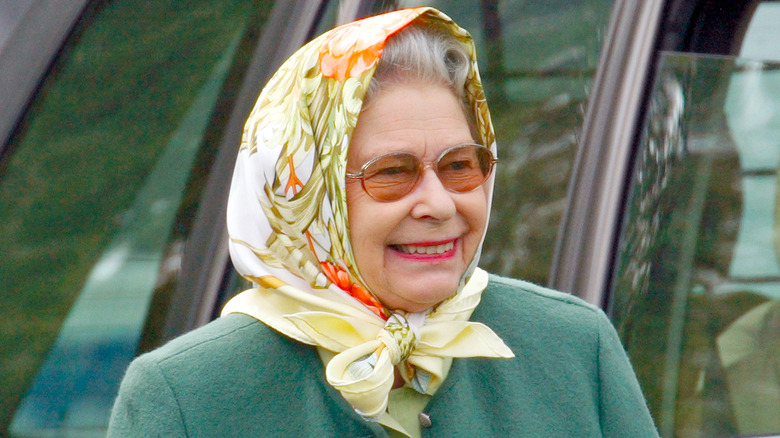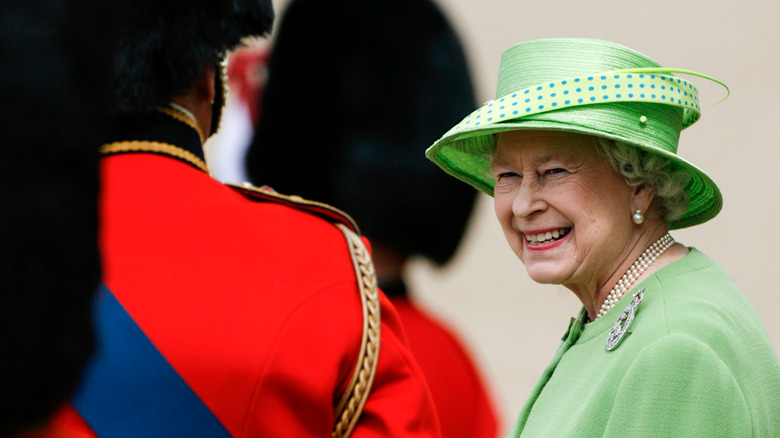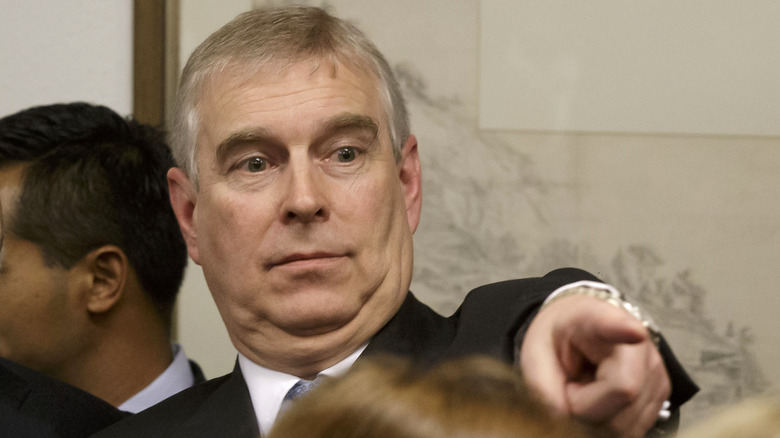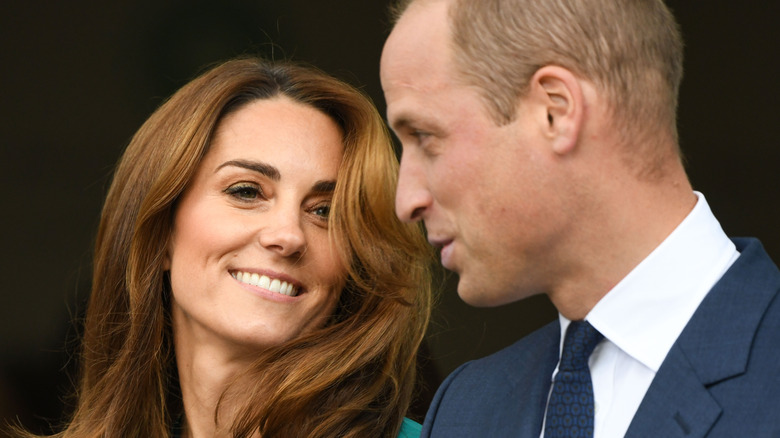The Truth About Royal Bodyguards
Almost immediately following Queen Elizabeth II's death, the royal family faced a slew of public appearances. In addition to funeral proceedings, King Charles III embarked on a mourning tour of the U.K., and the Prince and Princess of Wales increased their public activities. And while fulfilling royal duties, no royal will be without a bodyguard. These often nameless servants provide security, protection, and transportation for the royal family as they move about the business of The Firm.
Royal bodyguards provide 24-hour security for the highest ranking royal members, but they also provide transport and security for lower-ranking members of the family when they travel on royal business. They plan all of the security measures for large events, such as funerals and coronations. Upon the queen's death and the naming of a new monarch, for example, these royal bodyguards entered into extreme planning mode as they continue to carry out their daily duties for the evolving royal family (via USA Today).
Royal bodyguards have been around a while
The first official royal bodyguards in England, The Honorable Corps of Gentlemen at Arms, were banded together by Henry VIII in 1509, according to the royal family's official website. They were originally created to provide escort to the sovereign, in times of peace and war. In the modern age, their role is to serve the monarch as bodyguards in traditional public ceremonies such as the Garter service, the State Opening of Parliament, and other events. Their uniform consists of a red jacket and a helmet fastened with white swan feather plumes. As the late Queen Elizabeth once said, "The evils against which the Sovereign required protection in 1509 have I expect changed a little over the years but the loyalty of the Body Guard remains undimmed."
Members of the Royal Guard are also dressed in red and are easily recognizable in their tall, bearskin hats (via Insider). They are part of the Household Division of the British Army, and have the "unique responsibility for delivering State Ceremonial and Public Duties, primarily in London & Windsor," according to the division's website. "The Headquarters is based at Horse Guards on Whitehall."
The royal family is also supplied with personal protection officers – much less noticeable guards compared to the Gentlmen at Arms and Royal Guard. This protection for the British royal family is provided by the metropolitan police. Personal security detail does the majority of the planning for public appearances (and private security), as well as moves the royal throughout crowds and to new locations.
Royal bodyguards get to pick the code names for the royals
It's no secret that personal protection officers need code names for their protectees. But it isn't often that the public learns what type of names are used. Even more interesting, the Daily Mail reported that it's the royal bodyguards who choose the code names, not the royal family. The code names chosen for the royal family are simply more common names that use the same initials. For example, when Prince Harry and Meghan Markle were still working royals, their code names were David Stevens and Davina Scott. Before they were the Prince and Princess of Wales, the Duke and Duchess of Cambridge sported the aliases of Danny Collins and Daphne Clark.
These code names aren't whispered in hallways but are more often used in aides' and bodyguards' contact lists on their phones. According to a source quoted in the Daily Mail, "If anyone got hold of a phone belonging to a royal aide or a security team member, they won't find Harry Windsor and Meghan's names in it. It is far too risky in the wrong hands. They get given code names but they are changed regularly for obvious reasons."
They always have a plan
According to Simon Morgan, a former royal protection officer, the most important part of the role is not the fast cars or the show of force. "Planning is the most essential aspect of the role," he told Insider. He claimed the majority of his days were spent planning future trips and ventures for his protectees. "If you were to follow me for a day, you would see countless meetings about planning, journeys, telephone calls, and more meetings that discuss how the journeys will work." He continued, saying, "Bodyguarding is a thought process."
So, what do bodyguards think about? Well, Morgan claims it can take months or even years to plan a royal tour overseas. "There's tremendous weight attached to tours ... The actual threat is constant and you have to factor in different things according to the principal [who they are protecting]." If the principal is elderly or a child, their needs are wildly different from most adults. There are medical contingencies to consider as well. Royal bodyguards are always absolutely certain about the closest medical facility and the three most effective routes to get there.
In a separate interview, Morgan told 9Honey that one of the biggest challenges for a royal bodyguard was the ten to 15-minute "walkabout" where the royals greet the public. "So much could happen within that time, despite the fact you've tried to control so many factors beforehand." Imagine how stressed the royal protection officers must've been when, following the queen's death, the Duke and Duchess of Sussex together with the Prince and Princess of Wales spent almost triple the usual amount of time greeting well-wishers.
Royal bodyguards have strong nonverbal communication skills
In an interview with Insider, former royal bodyguard Simon Morgan described the primary way they keep royals safe when traveling. He claimed there is always an "unwritten understanding" between the security detail and the royal(s) being protected. It's important for royal family members to have a strong rapport with their bodyguards so they can communicate when they are uncomfortable in a situation without having to say a word. In the same way, the bodyguard is always communicating, albeit silently, by making a clear path for them in a crowd and being observant. Morgan explained further, saying, "If a protection officers says, 'we are leaving,' then we are leaving." Period.
As Morgan explained, bodyguards "don't have superhero type powers" — but they are trained to observe. They are observing both who they are in charge of protecting and the crowd around them. They are looking for something slightly different in both.
As he told 9Honey, "You're looking for your danger cues of individuals' behaviour and standard of dress, people's facial expressions, all these things are very much built up in your mind, and you're constantly observing and evaluating the information that's coming in to you."
They keep the convoy moving
The Special Escort Group (SEG) provides security and support as the royal family travels from place to place. They also protect VIPs and guests of the royal family when they arrive. Their main goal is to keep whatever convoy they are protecting moving at all times. While Americans might be accustomed to seeing a police escort with a long row of cars and flashing lights, the SEG moves their convoy through London with motorcycles, as "Inconspicuous Ingenuity" demonstrates.
Although this elite group of drivers trains and practices their traffic maneuvers with precision, this is still a risky job. According to the Daily Mail, while transporting Prince Harry to the Invictus Games in 2014, one of the outriders ran into a cab and was thrown 30 feet from his motorcycle. Per their training, the driver of Prince Harry's vehicle used evasive maneuvers to keep moving and get the royal to safety. Harry was seen visibly distraught through the windows of his Range Rover. The driver was released later that night, relatively unscathed.
There's another type of transport involved when it comes to the royal family: The Sovereign's Escort. This elite group of 120 riders and horses escorts the monarch during state visits or to the opening of parliament. Usually, the monarch is in a carriage, although, Queen Elizabeth II used to ride her own mount in some parades, with her escort by her side. As one former guardsman revealed in an article for iNews, "Historically [The Sovereign's] escorts would have been used as a bodyguard for the Sovereign when moving around the country, and the London to Windsor Escort was a common occurrence. Today this has been replaced with up-armoured black Land Rovers and police outriders, but sometimes — when diplomatic relations or national pride are at stake — only horse power will do."
Not all royal bodyguards are armed
Most royal protection officers are armed in some form. According to Elite UK Forces, most of them carry standard, military-issue 9 mm Glocks. This has not been without some mishaps, though. In 2000, BBC News reported that a royal guard accidentally discharged his weapon twice while riding on the royal train with Queen Elizabeth II and Prince Philip. The royals were sleeping only two cars away from where the officer shot two rounds into the dining car. The guard was immediately relieved of his duties while an investigation was made. The previous year, a royal guard accidentally discharged his gun while trying to empty it and the bullet ricocheted around St. James Palace before breaking a lower-floor window.
In 2020, The Sun reported that some royal bodyguards had their guns removed and replaced with tasers or stun guns. The late queen, King Charles II (then Prince Charles), and Prince William were still being guarded by officers with pistols, but members of the royal family further from the throne — including Princess Anne, Prince Andrew, and Prince Edward, as well as Prince Harry and Meghan — were no longer provided armed protection and their bodyguards were moved into an "advisory" role, meaning they were not to get involved with "potential attackers" (via The Sun).
This has been received with mixed reviews. Many of the officers expressed concerns about the efficacy of a stun gun. While the guns were very rarely, if ever, used, some officers felt they served as an effective deterrent in a crowd.
They love a good joke
During Queen Elizabeth's Platinum Jubilee in June 2022, Richard Griffin, former personal protection officer to the queen, told Sky News about a delightful moment he shared with the queen. The two were in Balmoral, Scotland. The queen would go on long walks, accompanied by Griffin, and left alone by the general population. She often included Griffin in her picnic. While on one of these hikes, they ran into two American tourists who failed to recognize the queen. The tourists mentioned they knew the moarch lived nearby and asked if either had met "Her Majesty." Queen Elizabeth replied, "Well, I haven't, but Dick here meets her often."
In response, the tourists asked the queen to take their picture posing with her royal bodyguard, who they knew as "Dick." Afterward, he casually suggested he should take their picture with "the lady," too. He told how both of them laughed after the tourists left and the queen expressed how she dearly wished to be a fly on the wall when they showed their picture to someone who would recognize her.
Richard Griffin served as the queen's royal protection officer for many years — and she even attended his retirement party (via Express).
Some royal bodyguards having rotating assignments
In 2017, Queen Elizabeth's security detail began rotating positions more frequently, much to her concern. The Standard reported that the queen worried too much rotating would keep them from recognizing when she was uncomfortable or in need of help. Because so much of a royal protection officer's job involves observing nonverbal cues from their principal, many reportedly expressed concern that rotating too many people too often would prevent this familiarity. The change was made after some restructuring occurred in the department responsible for royal security. As The Standard reported, "A number of senior officers are not happy either. Personal protection is all about building a relationship with the principal. How on earth is that supposed to happen if the officers are rotating every five minutes with new faces?"
Given that the queen suffered what History Extra calls "one of the biggest royal security breaches of the 20th century" when Michael Fagan climbed the walls of Buckingham Palace and joined the queen in her bedroom, Her Majesty's fears were not unfounded. When Fagan walked into the palace, the police on duty assumed the alarms he triggered were false and turned them off. He wandered into the queen's bedroom where he pulled aside her bed curtains. "They say she must have been frightened. I didn't frighten her too much but I was quite shocked," he told The Sun in 2020. He allowed the queen to leave the bedroom and call for help. After such an event, it's not surprising the monarch expressed concern that her royal guards might not be reliable.
Royal bodyguards can feel unappreciated
Paul Page, a former royal protection officer, told "60 Minutes" about an incident while he was on guard at Buckingham Palace. Prince Andrew brought his own protection officer with him and began hitting golf balls toward the lake. He then insisted that his royal bodyguard run and fetch the golf balls that hadn't gone into the water. Mr. Page was shocked that the "police officer was acting as a ball boy." He began to express his concern after the Epstein scandal was connected to the prince because, as he said, he was bullied by Prince Andrew and thus "suffered at the hands of the prince."
Page recounted to The Sun that he and several other officers once rushed to check on a possible intruder who appeared in the queen's quarters of Buckingham Palace. "But when we got there, we realised it was Prince Andrew. He looked scruffy and was wearing a tracksuit. Page said he apologized for the misunderstanding, but Andrew reportedly didn't take kindly to the mistake. According to Page, the prince replied, "This is my house, I go where I want, now f**k off." It should be noted that the source, Mr. Page, was once jailed for his participation in a property scam.
Similar "bullying" claims were once made against Meghan Markle Although Buckingham Palace investigated the claims, they remain confidential, according to BBC News. Given the close nature of the work, it stands to reason that the relationship between royal bodyguards and their principals could blur the lines between friendship and employee. As former protection officer Simon Morgan explained to Insider, being surrounded by "the best cars, yachts, and restaurants" can actually distract a bodyguard from providing the level of protection the royals need. "That's the principal's life, not yours. And if you don't understand that, you will be compromised," he said.
Some parts of the job are 'joyous'
Royal protection officer David Lombardi understood all too well the importance of the people he was guarding. He told Express about his experiences as a PPO for seven years. After he saw the queen crossing the garden for the first time, he said, "I couldn't stop thinking that this was the most famous woman in the world with a lineage going back 1,000 years and here I was passing the time of day with her." He continued, saying, "In all the time I worked as a Royal Protection Officer, I never got over that feeling."
He reported that during his time as a royal bodyguard, he "danced with the Queen, sneaked Princes William and Harry out on to The Mall the night before William's wedding to Kate Middleton, joked with Prince Charles and was blown kisses by baby Prince George." He told the publication that he was the one who deemed it okay for the princes to visit with the crowds on the night before William married Princess Catherine, then known as Kate Middleton. "Having done what is known as a dynamic risk assessment, I decided it was safe," he explained. Of course, he also supervised the outing. "I went out with them to keep an eye on everything," he revealed. "It was joyous and one of my most cherished memories of my time with the royals."
